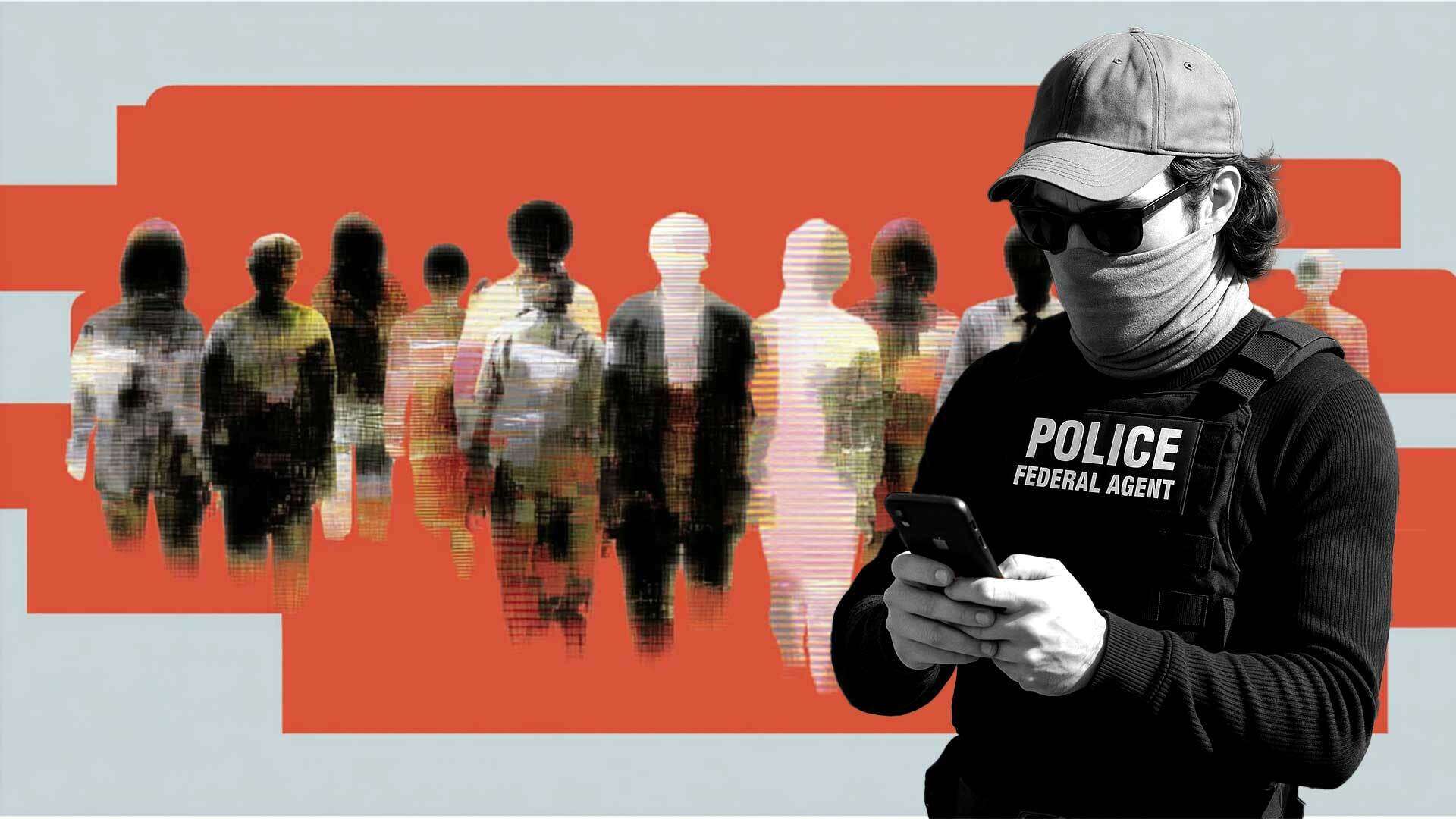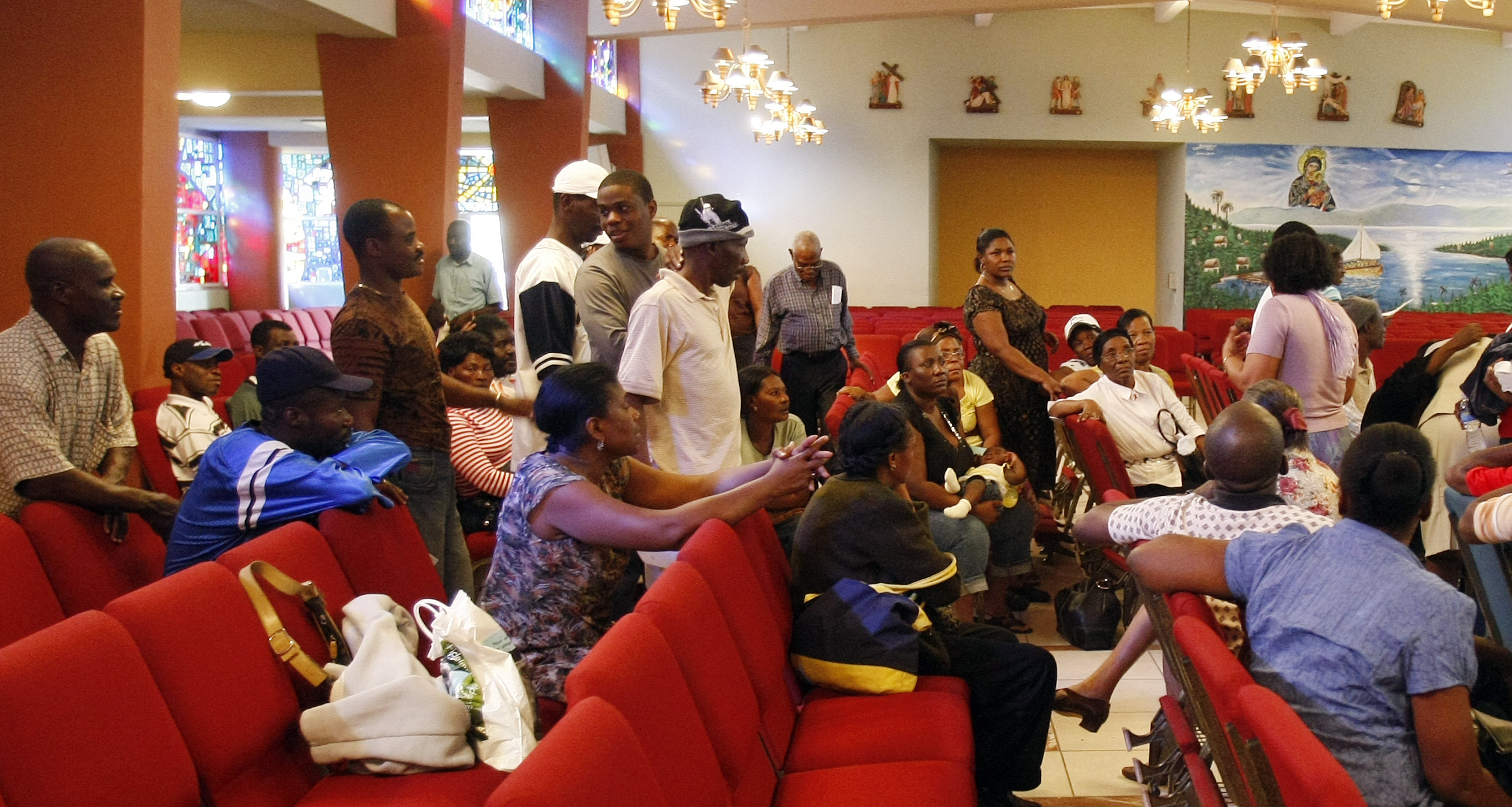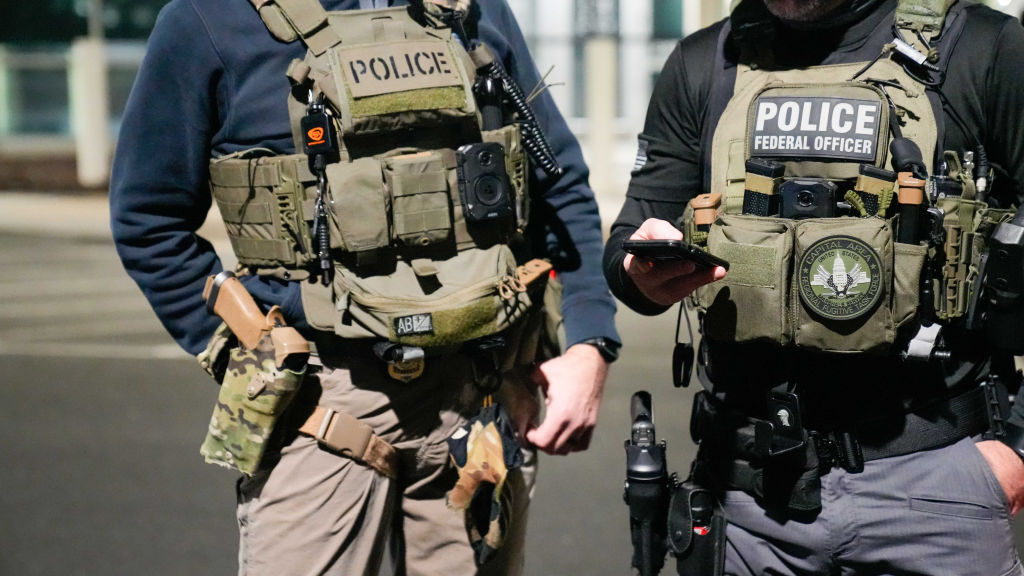Recent weeks have seen the Trump administration’s “mass deportation” program kick into overdrive.
Militarized federal agents are working hard to meet the White House’s sky-high arrest quotas, and the number of people in immigration detention is surging past record highs. That means focusing even more on otherwise law-abiding people who happen to have irregular immigration statuses ― people who pay taxes, show up to court dates and check-ins, work hard to provide for their families, and followed previous administrations’ rules to apply for humanitarian protections. It also means interrogating people at swap meets, and underground parties, or those who just have brown skin.
The nation disapproves, polling shows. Massive protests around the country ― in both large urban areas and small towns ― have showcased Americans’ fury at having their loved ones and neighbors ripped out of their communities at random.
Across the country, people are also taking action to slow down what they see as the egregious over-enforcement of immigration law, attempting to starve Trump’s mass deportation machine of fuel and to throw sand in its gears.
…
But activists and community organizers have worked for generations to slow down deportations ― and, as it turns out, Trump’s deportation agenda relies upon some crucial choke points. Here they are.
…
One key opportunity for bystanders to intervene in the deportation process comes during the actual moments where immigration agents may be making an arrest.
Take the case of Bishop-elect Michael Pham, Pope Leo XIV’s first bishop appointment in the United States. On World Refugee Day last week, Pham and other faith leaders visited an immigration court. The ICE agents who in recent weeks have been arresting immigrants showing up to routine hearings in the building “scattered” and did not take anyone into custody, Times of San Diego reported.
In Chicago, two National Guard soldiers appeared in uniform with their mother at her immigration appointment, alongside two members of Congress. The soldiers’ mother returned home without incident.
Not everyone has the star power to discourage detentions by their mere presence. But at courthouses and ICE check-ins where Trump has taken advantage of a legal maneuver known as “expedited removal” to arrest and deport people without due process, volunteers accompanying immigrants can document arrests and sometimes provide informal legal information to people who might not know about ICE’stactics.
…
Spreading information about people’s legal rights during interactions with law enforcement, known as “know your rights” information, has also grown enormously popular.
…
Getting Everyone Legal Representation: The data is clear. Legal representation is associated withbetter outcomes in immigration court.
That’s because the deck is stacked against people in the immigration legal system. Unlike in criminal court, people in the immigration process are not guaranteed free legal representation if they can’t afford it, even if they’re detained behind bars.
…
Opposing Local Cooperation With The Feds: Even though immigration enforcement is a federal job, local cooperation is a crucial part of the operation.
…
Fighting Trump’s Massive DHS Budget Increase
Tag Archives: Department of Homeland Security
Associated Press: Trump administration ends legal protections for half-million Haitians who now face deportations
The Department of Homeland Security said Friday that it is terminating legal protections for hundreds of thousands of Haitians, setting them up for potential deportation.
DHS said that conditions in Haiti have improved and Haitians no longer meet the conditions for the temporary legal protections.
The termination of temporary protected status, or TPS, applies to about 500,000 Haitians who are already in the United States, some of whom have lived here for more than a decade. It is coming three months after the Trump administration revoked legal protections for thousands of Haitians who arrived legally in the country under a humanitarian parole program, and it is part of part of a series of measures implemented to curb immigration.
https://apnews.com/article/tps-trump-immigration-haiti-temporary-ce021d96aeb81af607fcd5c7f9784c3b
That’s just one big lie (seem to get a lot of them out of the Trump administration). Here is the Dept. of State’s current travel advisory for Haiti:
Updated to reflect additional information on crime.
Do not travel to Haiti due to kidnapping, crime, civil unrest, and limited health care.
Country Summary: Since March 2024, Haiti has been under a State of Emergency. Crimes involving firearms are common in Haiti. They include robbery, carjackings, sexual assault, and kidnappings for ransom. Kidnapping is widespread, and U.S. citizens have been victims and have been hurt or killed. Kidnappers may plan carefully or target victims at random, unplanned times. Kidnappers will even target and attack convoys. Kidnapping cases often involve ransom requests. Victims’ families have paid thousands of dollars to rescue their family members.
Protests, demonstrations, and roadblocks are common and unpredictable. They often damage or destroy infrastructure and can become violent. Mob killings and assaults by the public have increased, including targeting those suspected of committing crimes.
The airport in Port-au-Prince can be a focal point for armed activity. Armed robberies are common. Carjackers attack private vehicles stuck in traffic. They often target lone drivers, especially women. As a result, the U.S. embassy requires its staff to use official transportation to and from the airport.
Do not cross the border by land between Haiti and the Dominican Republic due to the threat of kidnapping and violence. These dangers are present on roads from major Haitian cities to the border. The U.S. embassy cannot help you enter the Dominican Republic by air, land, or sea. U.S. citizens who cross into the Dominican Republic at an unofficial crossing may face high immigration fines if they try to leave. The U.S. Coast Guard has concerns about security in the ports of Haiti. Until those are addressed, the Coast Guard advises mariners and passengers traveling through the ports of Haiti to exercise caution.
The U.S. government is very limited in its ability to help U.S. citizens in Haiti. Local police and other first responders often lack the resources to respond to emergencies or serious crime. Shortages of gasoline, electricity, medicine, and medical supplies are common throughout the country. Public and private medical clinics and hospitals often lack trained staff and basic resources. In addition, they require prepayment for services in cash.
U.S. government personnel are subjected to a nightly curfew and are prohibited from walking in Port-au-Prince. Personnel movement is restricted throughout Haiti. U.S. government personnel in Haiti are also prohibited from:
- Using any kind of public transportation or taxis.
- Visiting banks and using ATMs.
- Driving at night.
- Traveling anywhere after dark.
- Traveling without prior approval and special security measures in place.
Read the country information page for additional information on travel to Haiti.
If you decide to travel to Haiti:
- Avoid demonstrations and crowds. Do not attempt to drive through roadblocks.
- Arrange airport transfers and hotels in advance, or have your host meet you upon arrival.
- Do not give personal information to unauthorized people to include those without uniforms or credentials. Individuals with bad intent may frequent areas at the airport, including near immigration and customs.
- If you are being followed as you leave the airport, drive to the nearest police station immediately.
- Travel by vehicle to reduce walking in public.
- Travel in groups or at least do not travel alone.
- Always keep vehicle doors locked and windows closed when driving.
- Be cautious and alert. This is especially important when driving through markets and other crowded areas.
- Do not fight back during a robbery. It increases the risk of violence and injury to you.
- Purchase travel insurance with medical evacuation coverage ahead of time.
- Review information on Travel to High-Risk Areas.
- Enroll in the Smart Traveler Enrollment Program (STEP) to receive Alerts and make it easier to locate you in an emergency.
- Follow the Department of State on Facebook and X/Twitter.
- Review the Country Security Report on Haiti.
Prepare a contingency plan for emergency situations. Review the Traveler’s Checklist.
Newsweek: Are ICE agents using facial recognition phone app? What we know
Immigration agents have been given access to a facial recognition app to identify people in the field, according to leaked emails.
The emails, exchanged between Immigration and Customs Enforcement (ICE) and Enforcement and Removal Operations (ERO) staff and contractors, allow officers to instantly compare biometrics like faces and fingerprints against Department of Homeland Security (DHS) databases, according to 404 Media.
…
The emails say that the biometric tool is best used “to identify unknown subjects in the field,” which, along with the contributions from staff at Enforcement and Removal Operations, suggests that it is being used in the Trump administration’s attempts to ramp up the removal of migrants without legal status.

https://www.newsweek.com/ice-face-recognition-app-deportations-phone-immigration-2091619
The Hill: Migrant deaths in ICE custody spark concerns
- 8 migrants have died in ICE detention centers since January
- Migrant rights groups allege insufficient medical care in ICE facilities
- ICE says every death at a facility is ‘a significant cause for concern’
A Canadian citizen held in a U.S. Immigration and Customs Enforcement detention center in Miami became the 11th person to die in an ICE facility since October after he was found unresponsive this week.
The agency said Thursday that Johnny Noviello, 49, died in the ICE facility and that his cause of death remains under investigation.
…
ICE officials say that any death that occurs in a detention facility is a “significant cause for concern” and that the agency prioritizes the health, safety and well-being of all migrants in ICE custody. Eight people have died in ICE detention centers this year alone — including four in Florida — according to federal data.
Noviello became a legal permanent resident in the U.S. in 1991 but was convicted in 2023 of racketeering and drug trafficking in Florida, ICE officials said this week. He was sentenced to spend a year in prison before he was arrested in May by ICE at the Florida Department of Corrections Probation office. He was given a notice to appear and was charged with being deported for violating state law.
…
In 2024, an American Civil Liberties Union report indicated that 95% of deaths that took place in ICE facilities between 2017 and 2021 could have been prevented or possibly prevented. The investigation, which was conducted by the ACLU, American Oversight and Physicians for Human Rights, analyzed the deaths of the 52 people who died in ICE custody during that time frame.
“ICE has failed to provide adequate — even basic — medical and mental health care and ensure that people in detention are treated with dignity,” Eunice Cho, a senior staff attorney at the ACLU’s National Prison Project and report co-author, said last year. “Abuses in ICE detention should no longer go ignored. It’s time to hold ICE accountable and end this failed, dangerous mass detention machine once and for all.”
The report alleged that ICE had “persistent failings in medical and mental care” that caused preventable deaths, including suicides. It also said that the federal agency failed to provide adequate medical care, medication and staffing.
Of the 52 deaths that the study analyzed, 88% involved cases in which the organizations found that incomplete, inappropriate and delayed treatments or medications contributed directly to the deaths of migrants being held in ICE custody.
Reason: How DHS Facial Recognition Tech Spread to ICE Enforcement
More government agencies are using facial recognition for enforcement than ever before.
Immigration and Customs Enforcement (ICE) is using a smartphone app to identify people based on an image of their fingerprints or face, 404 Media reported Thursday, based on a review of internal ICE emails. The expanding and repurposing of this sophisticated technology, ordinarily used by the Department of Homeland Security (DHS) when people are entering or exiting the country, is now being used on people living in the United States to meet mass deportation and arrest quotas imposed by President Donald Trump.
The app, Mobile Fortify, enables users to verify an unknown person’s identity in the field through contactless fingerprints and facial images on ICE-issued phones, according to an email sent to all ICE Enforcement and Removal Operations personnel and obtained by 404. According to the emails, Mobile Fortify can identify a person by comparing a photo of their face across two databases—Customs and Border Protection’s (CBP) Traveler Verification Service database of people’s photos taken when entering the United States, and Seizure and Apprehension Workflow, described by the Department of Homeland Security (DHS) as an “intelligence aggregator” that brings together information related to searches and seizures. For fingerprint matches, the app uses DHS’s centralized Automated Biometric Identification System, which “holds more than 320 million unique identities and processes more than 400,000 biometric transactions per day,” according to the agency.
A report released by the U.S. Commission on Civil Rights in September 2024 attempted to call attention to concerns about accuracy, oversight, transparency, discrimination, and access to justice as facial recognition tools have quickly proliferated. Although facial recognition technology is now available to the public through commercially available tools, policies governing the federal government’s use of the technology have lagged behind real-world applications. Currently, there are no comprehensive laws regulating the federal government’s use of facial recognition technology and no constitutional provisions governing its use.
“Face recognition technology is notoriously unreliable, frequently generating false matches and resulting in a number of known wrongful arrests across the country. Immigration agents relying on this technology to try to identify people on the street is a recipe for disaster,” Nathan Freed Wessler, deputy director of the American Civil Liberties Union’s Speech, Privacy, and Technology Project, told 404 Media. “Congress has never authorized DHS to use face recognition technology in this way, and the agency should shut this dangerous experiment down.“

https://reason.com/2025/06/27/how-dhs-facial-recognition-tech-spread-to-ice-enforcement
Newsweek: Trump administration terminates legal status for more than 500K immigrants
The Trump administration has announced the termination of Temporary Protected Status (TPS) for Haiti, impacting over 520,000 Haitian nationals residing in the United States.
Homeland Security Secretary Kristi Noem stated that the designation will expire on August 3, 2025, with the termination taking effect on September 2, 2025. This decision reverses an 18-month extension granted under former President Joe Biden‘s administration, which would have extended protections until February 2026.

https://www.newsweek.com/trump-admin-haiti-dhs-legal-status-tps-noem-2091814
ABC News: Trump administration expediting fines for those in the US illegally: Exclusive
New rule will eliminate the 30-day warning period before fines begin.
The Trump administration is looking to speed up its ability to fine those in the United States illegally — up to $1,000 per day — according to a rule set to be published Friday in the Federal Register that was obtained by ABC News.
Currently, the government can alert those in the U.S. illegally 30 days before it starts issuing fines.
The rule proposed by the departments of Justice and Homeland Security allows the government to immediately start fining those in the U.S. illegally.
Salon: “Unlawful and unconstitutional”: Lawsuits against ICE mount nationwide for “unconscionable” actions
A series of lawsuits against ICE highlight the legal grey areas the agency exploits for Trump’s deportations
President Donald Trump‘s mass deportation agenda has left law enforcement agencies across the country facing numerous lawsuits.
Outside of lawsuits against Immigration and Customs Enforcement, local police departments are being dragged into court for cooperating with largely unpopular deportations and raids. In New York’s Nassau County, one lawsuit argues that a partnership between police and ICE is “unlawful.”
…
In Washington, D.C., watchdog organization American Oversight is suing over access to documents concerning immigration procedures.
The group seeks records related to recent actions taken by ICE, such as entering schools and churches, along with internal records of Trump’s decision to deploy the National Guard to Los Angeles. The lawsuit calls the deportations “aggressive, sweeping, and by the President’s own tacit admission<—politically motivated.” In San Antonio, a Honduran mother is suing the Trump administration over her family’s detention by ICE. The woman was detained during a visit to Los Angeles Immigration court, along with her two young children, one of whom has leukemia.
The arrest was part of a larger ICE policy of seeking out migrants attempting to navigate their legal status in the country, with particular focus on immigration hearings. New York City Comptroller Brad Lander was arrested during one such confrontation after asking to see an arrest warrant from federal agents.
The family in the Los Angeles case were attending asylum status hearings. They have since been detained in Dilley Immigration Processing Center in Texas.
“The horrors that this family has suffered should never be felt by a child in need of medical care. Arresting immigrants as they step out of a courtroom is a heinous display of disregard for humanity. This family came to the United States seeking safety, but inhumane policies are preventing them from seeking necessary medical care for their child,” said Kate Gibson Kumar, a staff attorney for the Texas Civil Rights Project Beyond Borders program.

Also here:
Associated Press: Family sues over US detention in what may be first challenge to courthouse arrests involving kids
A mother and her two young kids are fighting for their release from a Texas immigration detention center in what is believed to be the first lawsuit involving children challenging the Trump administration’s policy on immigrant arrests at courthouses.
- A mother, her 6-year-old son and 9-year-old daughter are fighting for their release from a Texas immigration detention center
- The lawsuit says the family’s arrests after fleeing Honduras due to death threats and entering the U.S. legally using the CBP One app violate their Fourth and Fifth Amendment rights
- Elora Mukherjee, a lawyer representing the family, said this is the first lawsuit filed on behalf of children to challenge the ICE courthouse arrest policy
- Mukherjee said the son recently underwent chemotherapy for leukemia and his health is declining in detention. The lawyer said after their arrest at a courtroom, the family spent 11 hours at an immigrant processing center and were each only given an apple, a small packet of cookies, a juice box and water
The lawsuit filed Tuesday argues that the family’s arrests after fleeing Honduras and entering the U.S. legally using a Biden-era appointment app violate their Fourth Amendment right to be free from unreasonable searches and seizure and their Fifth Amendment right to due process.
“The big picture is that the executive branch cannot seize people, arrest people, detain people indefinitely when they are complying with exactly what our government has required of them,” said Columbia Law School professor Elora Mukherjee, one of the lawyers representing the family.
…
Starting in May, the country has seen large-scale arrests in which asylum-seekers appearing at routine court hearings have been arrested outside courtrooms as part of the White House’s mass deportation effort. In many cases, a judge will grant a government lawyer’s request to dismiss deportation proceedings and then U.S. Immigration and Customs Enforcement officers will arrest the person and place them on “expedited removal,” a fast track to deportation.
Mukherjee said this is the first lawsuit filed on behalf of children to challenge the ICE courthouse arrest policy. The government has until July 1 to respond.

https://baynews9.com/fl/tampa/news/2025/06/27/family-sues-us-detention-courthouse-arrests
Huffington Post: 6-Year-Old With Leukemia In Immigration Detention After Family’s Arrest At Courthouse: Lawsuit
Attorneys for the boy, his mother and 9-year-old sister said they are seeking asylum and were summarily arrested despite appearing for their scheduled immigration court hearing.
A mother and her two young children — one a 6-year-old boy with leukemia — were detained by immigration officers after going to a routine immigration court proceeding in Los Angeles. Now, the family is suing the Trump administration while being detained at a facility in Texas.
According to court documents obtained by HuffPost, the family, whose names are not included in the suit, has been in the U.S. for seven months seeking asylum from Honduras. They entered the country lawfully and were granted parole as they sought asylum. However, when they arrived at the courthouse on the day and time directed, their case was dismissed, and they were detained by people, presumably federal agents, in plainclothes.
“There were men waiting for them in civilian clothing. The [immigration officers] detained the family for many hours, and it was a terrifying time for the two children and their mother,” Elora Mukherjee, director of the Immigrant Rights Clinic at Columbia Law School, told Texas Public Radio.
“They were crying in fear. One of the agents at one point lifted up his shirt, which displayed the gun that he was carrying,” Mukherjee added. “The 6-year-old boy was terrified to see the gun. He urinated on himself and wet all his clothing. No one offered him a change of clothing for many hours.”




